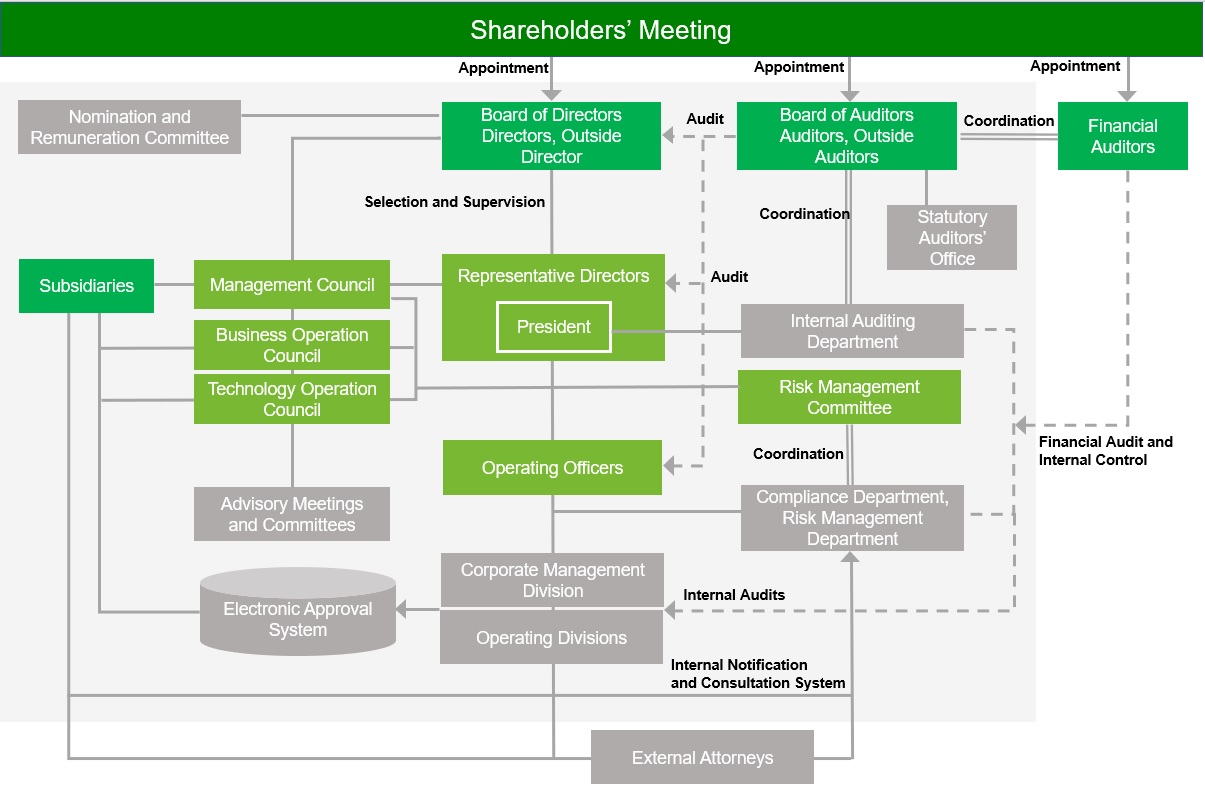We strive to strengthen corporate governance to ensure transparency and objectivity in management.
Basic Approach to Corporate Governance
Haseko Corporation has made it a basic policy of its corporate management to contribute to society and win society's confidence through its business operations that put customers first. The Company has also positioned reinforcement of corporate governance as one of its utmost management priorities as it recognizes that it is indispensable to secure management transparency and objectivity for maximizing corporate value in a stable manner over the long term and ensuring shareholders' interests.
Basic Explanation of company institutions
The Board of Directors of Haseko Corporation serves as the institution where directors with expert knowledge and experience in various business sectors conduct decision-making on managerial issues and supervise execution of duties of other directors. As for monitoring of management operations, the Company's system provides the Board of Auditors, the majority of which are outside auditors, with the monitoring function from an objective and neutral standpoint from outside through implementation of audits. On top of these functions, starting in June 2016, Haseko appointed outside directors with abundant experience and track record to occupy at least one third of the Board of Directors, so that they shall provide appropriate opinions and advice in order to further activate discussions at the Board of Directors as well as enhance the function to monitor business management. Going forward, we will continue to look for a system that is optimum for the Company, taking into consideration the balance between the operation of the Board of Directors and the monitoring functions.
Moreover, decision-making on certain matters authorized by the Board of Directors is made at the Management Council and two operation councils – the Business Operation Council and the Technology Operation Council – to which participation of the Directors are limited to a certain level. By doing so, the functions of making decisions and supervising such decision-making are divided. The system allows each Director to supervise the execution of duties by other Directors.
Moreover, the function of discussing in advance the important issues to be decided at the Board of Directors is performed by the Management Council.
Diagram of company institutions and internal governance

Details of company institutions
- (1)The Board of Directors holds regular meetings once a month and additional special meetings as necessary, and is responsible for important decision-making and regular reports on matters related to management. In addition, operating officers make operational reports on a regular basis to the board. With Chairman and Director Noriaki Tsuji as its chair, its members include Kazuo Ikegami, Satoshi Kumano, Shoji Naraoka, Kuniyoshi Mimori, Toru Yamaguchi, Naoko Yoshimura; Outside Directors Kazuhiko Ichimura, Mami Nagasaki, Toshikatsu Ogura, Shinsuke Fujii, and Takeshi Fujii; full-time Corporate Auditors Eijo Daimon and Noriyuki Tsutsui; and Outside Corporate Auditors Yoshitaka Fukui, Mitsuo Isoda, and Nobuyuki Iijima
- (2)The Nomination and Remuneration Committee is an advisory body for the Board of Directors, to secure objectivity, transparency and fairness of the procedures related to the nomination and remuneration, etc. of Directors and enhance corporate governance. The committee comprises all independent Outside Directors and an equivalent or below number of Representative Directors, etc.With President and Representative Director Satoshi Kumano as its chair, its members include Noriaki Tsuji, Kazuo Ikegami and Outside Directors Kazuhiko Ichimura, Mami Nagasaki, Toshikatsu Ogura, Shinsuke Fujii, and Takeshi Fujii.
- (3)The Company has established the Management Council and two operation councils – the Business Operation Council and the Technology Operation Council – to facilitate prompt and flexible decision-making on matters related to daily operations to the extent they are authorized by the Board of Directors. Participation of Directors in the Management Council and two operation councils is limited to a certain level, so that the functions of making decisions and supervising such decision-making are divided and clarification is made for the responsibilities and authority for these functions. Moreover, the function of discussing in advance the important issues to be decided at the Board of Directors is performed by the Management Council.
- (4) The Risk Management Committee is held once every quarter, and shall also be held on an ad hoc basis as necessary whenever any material risk has arisen. It examines and determines the establishment, amendment or abolishment of internal rules on risk management and risk prevention plans, etc., as well as discusses and decides on the implementation policies and specific measures for risk management, among other things. With President and Representative Director Satoshi Kumano as its chair, its members include Shoji Naraoka, Kuniyoshi Mimori, Satoshi Kumano, Toru Yamaguchi, Naoko Yoshimura, and 15 Operating Officers responsible for Risk Management Committee.
| Basic Policy on Corporate Governance | |
|---|---|
| Corporate Governance Report |
Corporate Governance Report [PDF:671KB](As of Nov. 12, 2025) |
